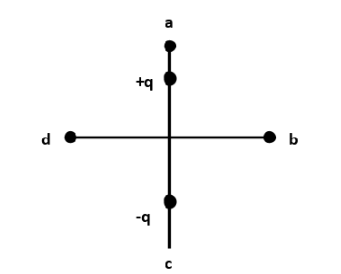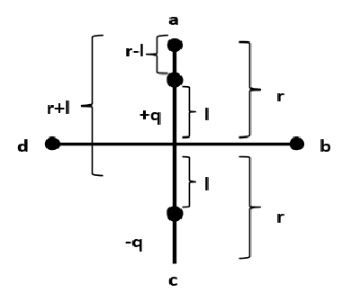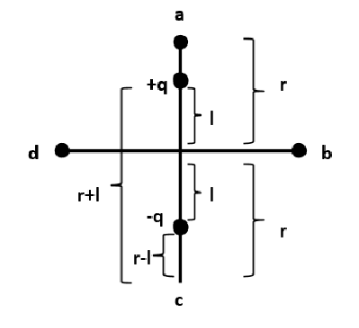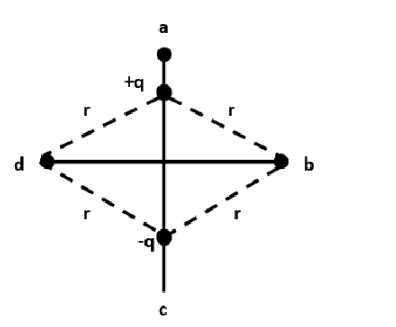Question
Question: Four points \[a,b,c \] and \[d \] are set at equal distance from the center of a dipole as shown in ...
Four points a,b,c and d are set at equal distance from the center of a dipole as shown in the figure. The electrostatic potential Va,Vb,Vc and Vd would satisfy the following relation:

A. Va>Vb>Vc>Vd
B. Va>Vb=Vd>Vc
C. Va=Vc>Vb=Vd
D. Vb=Vd>Va>Vc
Solution
It is given that four points a,b,c and d are set at equal distance from the center of a dipole. Then the expression for electrostatic potential of a charge placed at a point distant r from the origin is given by V=4πε0k1rq where, ε0 is the permittivity of vacuum, r is the distance of the charge and q is the charge (either positive or negative).
Electrostatic potential due to positive source charge is positive and negative source charge is negative.
Formula Used:
Electrostatic potential of a charge placed at a point distant r from the origin is given by
V=4πε0k1rq
Complete step by step solution:
a,b,c and d are the four points. Let the electrostatic potential generated by them be and Vd respectively. Let the distance of positive charge +q and negative charge −q be from the center of the dipole be l . Let the four points a,b,c and d be set at equal distance r from the center of a dipole.

So, the distance of charge point a from charge +q is =r−l , and that from charge −q is =r\+l . The value of electrostatic potential Va due to charge +q will be
Va=4πε0k1(r−l)+q or Va=4πε0kq(r−l)1 →(1)
And that due to charge −q will be
Va=4πε0k1(r+l)−q or Va=4πε0kq(r+l)−1 →(2)
The total potential at point a will be (Adding equations (1) and (2) )
⇒Va=4πε0kq[(r−l)1−(r+l)1] ⇒4πε0k1[(r−l)(r+l)(r+l)−(r−l)] ∴Va=4πε0k1[r2−l22l]→(3)
Similarly, the distance of charge point c from charge +q is =r+l , and that from charge −q is =r−l .

The value of electrostatic potential Vc due to charge +q will be
Vc=4πε0k1(r+l)+q or Vc=4πε0kq(r+l)1 →(4)
And that due to charge −q will be
Vc=4πε0k1(r−l)−q or Vc=4πε0kq(r−l)−1 →(5)
The total potential at point a will be (Adding equations (4) and (5) )
⇒Vc=4πε0kq[(r+l)1−(r−l)1]
⇒4πε0k1[(r+l)(r−l)(r−l)−(r+l)] \therefore {V_c} = \dfrac{1}{{4\pi {\varepsilon _0}k}}\left[ {\dfrac{{ - 2l}}{{{r^2} - {l^2}}}} \right] \to (6) \\\
According to equation (3) and equation (6), the magnitude of electrostatic potential is the same for points a and c . Therefore, Va=Vc .
Points b and d are equidistant from both the charges, positive as well as negative. Therefore, the electrostatic potential Vb and Vd will be zero. Thus, Vb=Vd . Since, Va and Vc are greater than zero, therefore Va=Vc>Vb=Vd
Hence, option (C) is the correct answer.
Note: The electrostatic potential at Vb and Vd is taken as zero since points b and d are equidistant from both the positive and negative charges. This can also be worked by applying the formula.

Let the distance of points b and d from the charges be r (Refer the diagram below). Then, the electrostatic potential Vb will be
Vb=4πε0k1r+q or Vb=4πε0kqr1 →(7)
And that due to charge −q will be
Vb=4πε0k1r−q or Va=4πε0kqr−1 →(8)
The total potential at point a will be (Adding equations (7) and (8) )
\Rightarrow {V_b} = \dfrac{q}{{4\pi {\varepsilon _0}k}}\left[ {\dfrac{1}{r} - \dfrac{1}{r}} \right] \\\
\Rightarrow \dfrac{1}{{4\pi {\varepsilon _0}k}}\left[ 0 \right] \\\
\therefore {V_b} = 0 \\\
Similarly, Vd=0
Thus, electrostatic potential is zero at points b and d .
